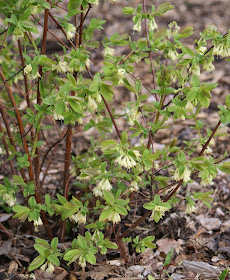 |
| Tree peonies in bloom |
A bit later than usual this year, due to the cool spring I suppose. This is Luoyang Hong (Luoyang Red), a very reliable magenta tree peony.
 |
| Tree peony 'Luoyang Hong' |
It is only 5-6 years old this year, but is blooming quite well for a young'un. I believe it had 7 flowers this year.
 |
| Tree peony 'Luoyang Hong' |
I adore this white tree peony called Xiang Yu (Fragrant Jade). It is fragrant indeed - sweet and strong yet delicate in texture. It is the most fragrant tree peony I have ever encountered.
 |
| Tree peony 'Xiang Yu' |
It is a tall, slender peony with large flowers that get tousled by the wind. It is 5-6 years old this year and had 7 blooms.
 |
| Tree peony 'Xiang Yu' |
I love its striking red carpels and filaments.
 |
| Tree peony 'Xiang Yu' |
My so-called "black" (really dark maroon-red) tree peony blooms a bit later than the other two in this area. It usually overlaps with them but starts in later. It has not yet opened all its blooms.
 |
| Tree peony 'Wu Jin Yao Hui' |
The petals of this one have a unique shiny luster. It is difficult to photograph because the color is so dark. "Black" tree peonies are generally slow growing. This one is about 9 years old and has 10 flowers this year. It has an intriguing, musky-sweet fragrance, very "peony" like. This variety has some flowers at the top of the plant, but some buried inside the bush.
 |
| Tree peony 'Wu Jin Yao Hui' with Rue, Candytuft, and Lamb's Ears |
I'm very excited that my new Rockii peony bloomed this year. This is its first spring in my garden, so it's a treat to have even one bloom.
 |
| Paeonia rockii 'Rock's Variety' |
Rockii peonies can grow quite large and have many blooms. It has a pleasant, sweet fragrance (although not nearly as strong as Xiang Yu). Aren't those purple blotches fabulous?
 |
| Paeonia rockii 'Rock's Variety' |
My one small disappointment is that my fifth tree peony (a coral-pink variety called Shan Hu Tai, or Coral Terrace) has no buds this year. Bummer! This is its second spring in my garden, and the plant is probably about 4 years old, so I was hoping for a sample flower. But this is not unusual for tree peonies - some do not bloom until they are 5-6 years old. The foliage looks healthy and the plant is growing well, so we'll just have to keep our fingers crossed for next year...









.JPG)

































